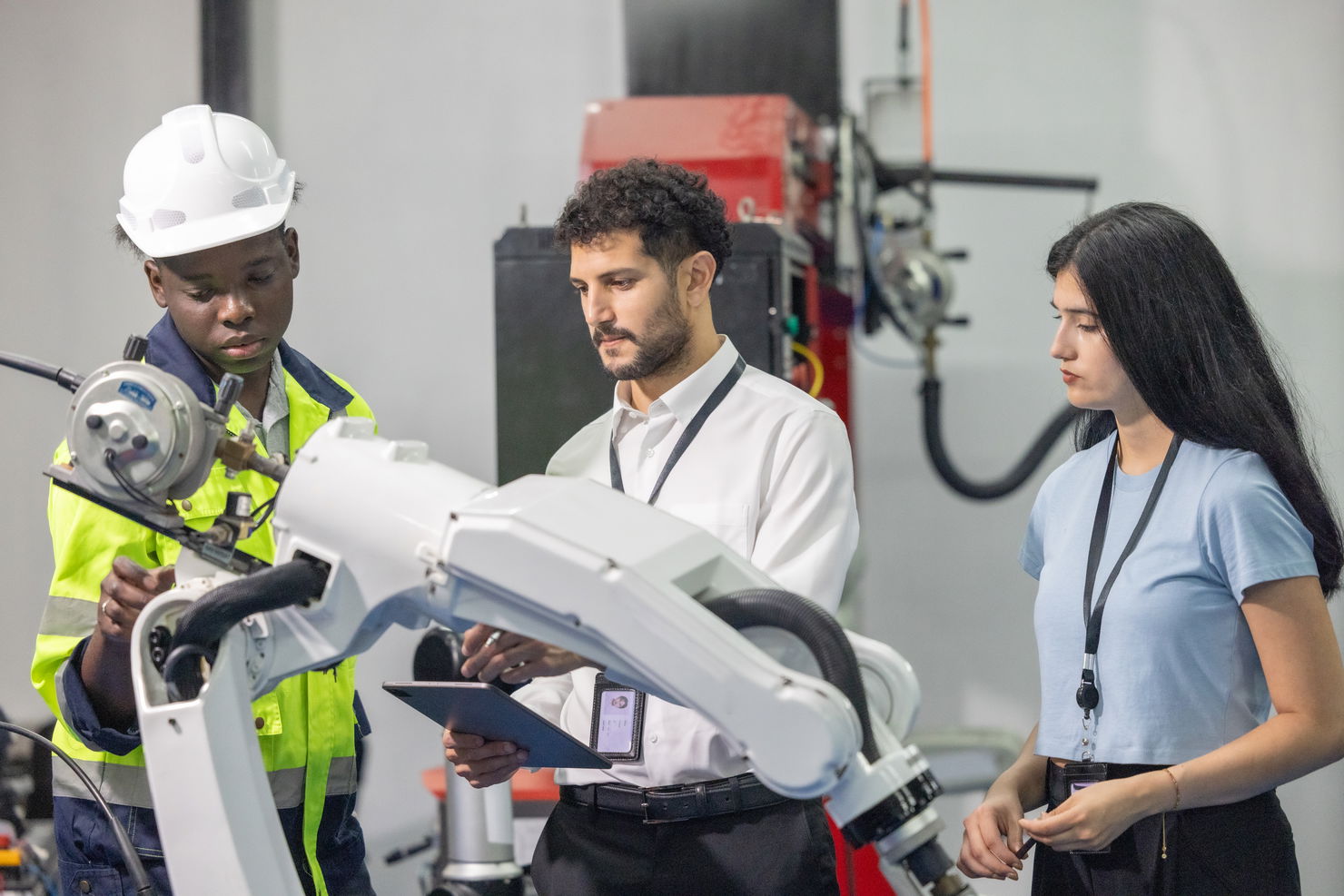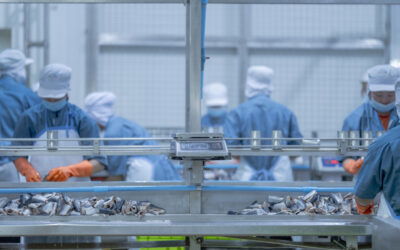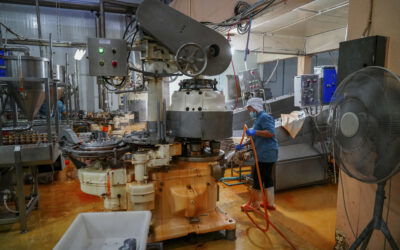MES and ERP system integration—this factory could turn daily losses into profits through seamless synchronization, full data visibility, and rapid, informed decision-making at every moment. MES system system for the field, an ERP for global management – these losses can be transformed into performance gains. At TEEPTRAK, we’ve seen many industrial companies significantly boost their efficiency simply by understanding and properly integrating these two solutions. In this article, let’s explore together how to select, combine, and leverage the full potential of these systems to unlock the true power of your production.
Comparing MES and ERP: Why does it matter?
A Key Decision to Optimize Your Industrial Performance
In an increasingly demanding industrial environment, choosing between MES software and an ERP system – or opt for an integration of the two — is not insignificant. A poor decision can slow down processes, generate unnecessary costs, or create information silos between. workshopthe resources human resources planning and operations. Conversely, a clear understanding of the roles and complementarities of each tool helps to align priorities: real-time production control, structured order and stock managementinventory management qualityand resource optimization. This is a strategic challenge for any industrial company wishing to combine operational efficiency and overall control of its production system.
✅ Expert advice “Before choosing a system, ask yourself the following question: ‘Do I need to pilot my production in real time, or centralize my management data?'”
Context: digital transformation and factory digitalization
The digital transformation has now become an essential step in the industrial sector. To meet the growing demands for traceabilityflexibility flexibility and performancehas now become an essential step in the industrial sector. To meet the growing demands, companies are modernizing their tools: automated data collection, remote monitoring, real-time analysis, and more. In this context, solutions such as MES and ERP software have become crucial for structuring information flows, improving manufacturing processes, and ensuring optimal use of machines and resources. industry 4.0 isn’t just about automation: it’s about intelligent data management for responsive, competitive production.
✅ Key figure 70% of industrial companies have begun a project to digitalize their operations in the last 3 years (source: McKinsey)”.
Decoding ERP: the company’s comprehensive management system
Definition, Objectives, and Functional Scope
A ERP (Enterprise Resource Planning) is an integrated integrated management software designed to centralize and structure all the processes of an industrial industrial company : purchasing, human resources, finance, inventory management, order processing, and planning. It enables unified handling of data and ensures the consistency of information between departments.
Main objectives of an ERP:
- Ensure traceability of information flows
- Reduce redundant tasks through automation
- Facilitate planning planning
- Provide an overview to support decision-making
Key functions: finance, supply chain, HR, etc.
| ERP Module | Main function |
|---|---|
| Finance | Budget monitoring, accounting, cash flow |
| Human Resources | Management of schedules, salaries, training |
| Purchasing | Supplier orders, validation, follow-up |
| Production | Master production plan, bills of materials |
| Stock / Logistics | Monitoring of levels, movements, inventories |
| Sales / CRM | Management of orders, customers, quotes |
Limitations of an ERP in the context of real-time production
ERP manages theglobal orderbut is ill-suited to instantaneous management of a workshop or formachine information. It does not track minute-by-minute events, nor performance in real time.
✅ Myth vs reality : “ERP doesn’t allow you to track production minute by minute.”
Decoding MES: the Manufacturing Execution System
Definition, missions, and role in the workshop
A MES (Manufacturing Execution System) is an industrial industrial execution software that operates as close as possible to production operations. Unlike the ERP, it operates in real time in theworkshopdirectly connected to the machinesto processesand to operators.
Its roles:
- Track the progress of manufacturing orders
- Collect field data (OEE, downtime, quality, etc.)
- Alert in case of deviation or inefficiency
- Improve coordination of resources and technical resources
It acts as a direct interface between management information systems and the reality reality in the field.
ISA-95 key features
📊 The 11 MES functions (ISA-95) :
- Detailed scheduling
- Resource management
- Production monitoring
- Quality monitoring
- Document management
- Performance monitoring
- Maintenance management
- Root cause analysis
- Material tracking
- Non-conforming product management
- Report generation
✅ Worth noting ISA-95 is the international standard for connecting ERP and MES.
MES and OEE: Impact on Industrial Performance
Thanks to its real-time datadata, an MES enables instant visualization and improvement of the TRS (Synthetic Yield Rate). By identifying micro-disruptions, quality defects or slowdowns, it reveals concrete levers for improvement. efficiency.
📈 Customer example At Nutrisetthe implementation of our PerfTrak solution has eliminated over 100 microstops per shift, with a direct impact on overall overall OEE and machine availability.
✅ Case study We were able to eliminate a maximum number of ‘irritants’, those small, invisible but very costly stoppages.” – Sylvain Clausse, EIA Coordinator, Nutriset
MES vs ERP: what are the fundamental differences?
Action levels (operational vs. strategic)
L’ERP acts at the strategic and organizational It structures the company for the long term, planning resources and consolidating all management data.
Visit MESon the other hand, intervenes at the operational level operationaldirectly in the field. It continuously captures, processes and feeds information from the workshopto control each stage of the manufacturing process manufacturing process.
Functional hierarchy :
Management (ERP) → Middle Management (ERP/MES) → Operators & Machines (MES)
Data Timeliness and Responsiveness
| Criteria | ERP | MES |
|---|---|---|
| Update frequency | Hourly, daily | Second, minute |
| Nature des données | Agrégées, consolidées | Brutes, temps réel |
| Réactivité | Moyenne à lente | Immédiate |
| Source d’information | Utilisateurs, formulaires | Capteurs, machines, opérateurs |
Utilisateurs cibles et types de décisions
ERP :
- General Management
- Management controllers
- Logistics, finance and HR managers
MES :
- Team leaders
- Production managers
- Workshop operators
- Quality & maintenance managers
Comparaison visuelle : tableau récapitulatif MES / ERP
| Dimension | ERP | MES |
|---|---|---|
| Main objective | Global management | Production execution |
| Données traitées | Administratives, commerciales | Opérationnelles, terrain |
| Temporality | Long term / planned | Short term / real time |
| Users | Managers, CFOs, HR | Operators, line managers |
| Precision level | Global | Granular |
| CMMS integration possible | Limited | Yes, directly linked to workshop |
| OEE steering | No | Yes |
| Interaction machine | Indirecte | Directe |
MES + ERP Integration: A Performance Booster
Why Connect Them? Real-World Examples
In a modern plant, connecting the MES system to theERP ensures digital continuity between shop floor operations and management processes. On one side, the MES captures real-time data linked to productionand qualityor maintenance. On the other, the ERP uses this information to adjust the planningmonitoring resourcesor process orders.
This integration creates a virtuous cycle:
- The ERP production orders are executed and monitored by the MES
- Shop floor feedback provides the ERP with reliable data
- The discrepancies between planned and actual are identified, analyzed, and then corrected
✅ Key benefit Fluidity of information flows from the shop floor to strategic reporting”.
Results achieved with our clients (ROI, OEE, productivity)
TEEPTRAK has supported numerous industrial companies in this integration.
Examples of concrete results:
- +29% parts/hour on a PerfTrak-equipped machine (source: TEEPTRAK customer)
- 10 to 15 OEE points gained on average on the lines observed
- Operator time reduced thanks to automated data collection.
✅ Key figure 29% more parts/hour on a Teeptrak-equipped machine”.
Use case: how TEEPTRAK easily connects MES and ERP.
Our solutions such as PerfTrak installed within a few hours, without modifying your existing systems. Thanks to their native compatibility with industrial ERPs, they ensure smooth information synchronization.
🎤 Customer testimonial :
“The PerfTrak solutions have enabled us to gain 10 to 15 TRS points, but also precious time for operators, who no longer have to fill in any documentation.”
– Philippe Devaux, Industrial Process Manager, Hutchinson Group
Choosing between MES, ERP, or both?
Evaluation criteria for making the right choice
The choice between a MESan ERPor their integration depends on your company’s context. Here are a few criteria to guide your decision:
Key criteria to consider :
- Digital maturity level: beginner or advanced?
- Priority objective optimize production flows or structure overall management ?
- Company size: microenterprise, SME, or industrial group?
- Field piloting required in real-time or not?
- Budget and expected return on investment (ROI)
Mini decision-making grid :
| Your need | Recommended priority |
|---|---|
| Track production in real time | MES |
| Structure the entire company | ERP |
| Handle both aspects | Integrated MES + ERP |
Progressive approach recommended by TEEPTRAK
We often recommend start with a lightweight MESquick to deploy, to gain gain visibility on TRS,quality, and downtimes. This allows you to identify your performance levers before moving toward an integrated solution.
✅ Practical tip Start by measuring your OEE before digitizing the entire chain”.
Interactive tool: calculate your ROI in 2 minutes
💡 Use our simulator to estimate your return on investment in just a few clicks. return on investment of our solutions:
👉 Calculate your ROI with Teeptrak
FAQ – Your most frequently asked questions
What is the difference between an ERP and an MES?
L’ERP centralizes overall management (inventory, orders, HR), while the MES monitors and optimizes production operations in real time, directly in the field.
MES vs WMS: what are the differences?
Visit WMS (Warehouse Management System) manages inventories and warehouse logistics. Visit MES, on the other hand, focuses on manufacturing, production order tracking, quality, and shop floor performance.
ERP, MES, MIS: who does what?
L’ERP pilots the company as a whole, the MES manages workshop execution, and the MIS (Management Information System) provides analytical reports for strategic decision-making.
CRM, ERP, MES: how to coordinate these tools?
Visit CRM manages customer relations, theERP transforms orders into internal orders, and the MES executes them on the shop floor. Together, they create a continuous flow of information from sales to production.
MES vs ERP: two pillars of smart manufacturing
The key: integrate to manage performance in real time
MES and ERP are not opposed: they complement each other. One operates on the shop floor, the other within the organization.. Their integration enables a global visionand precise executionand better use of resources resources.
Unleash the power of your production with TEEPTRAK
At TEEPTRAKwe help you connect these systems simply, to boost your industrial efficiency right from the start.
🎯 Discover our solutionsschedule a demo or test our ROI simulator to measure the immediate impact on your factory.
✅ Checklist :
- Measure your OEE
- Identify hidden losses
- Deploy an MES solution connected to your ERP





0 Comments